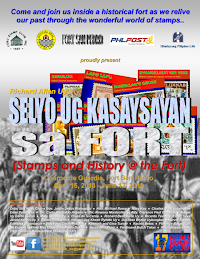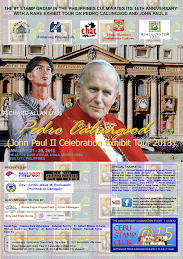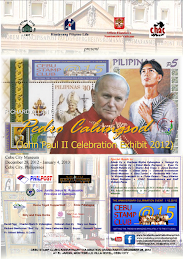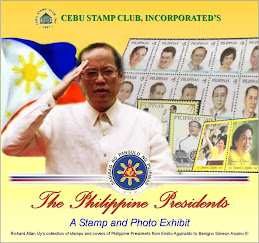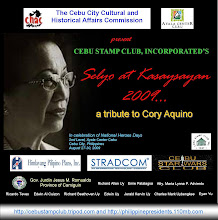Today in Philippine History:
JULY 5, 1945
Gen. Douglas MacArthur in a GHQ communiqué announced that “the Philippines had been liberated and all operations ended.” This was announced even though Japanese Gen. Tomoyuki Yamashita, the Tiger of Malaya was still held out in northern Luzon. The fighting went on as the Japanese continued to resist until Yamashita surrendered in Ifugao on the same day Gen. Yoshijiru Umezu formally surrendered for Japan on September 2, 1945 onboard the USS Missouri. MacArthur was awarded the Congressional Medal of Honor for defending the Philippines.
Photo credit: http://en.wikipedia.org/
Saturday, July 5, 2014
Today in Philippine History: Manuel Sityar
Today in Philippine History:
JULY 5, 1896
Lt. Manuel Bernal Sityar, a Spanish mestizo and a Guardia Sibil (Civil Guard) stationed in Pasig wrote a confidential letter to the Governor General that certain individuals in Mandaluyong and San Juan del Monte were enlisting people for unknown reasons and making them sign a pledge in blood. On August 30, 1896, The Philippine revolution began as 800 Katipuneros headed by Andres Bonifacio attacked the polverin, a Spanish powder magazine in San Juan del Monte. In 1898, Sityar being half-Filipino defected to Emilio Aguinaldo’s army and was promoted colonel.
Photo credit: http://
JULY 5, 1896
Lt. Manuel Bernal Sityar, a Spanish mestizo and a Guardia Sibil (Civil Guard) stationed in Pasig wrote a confidential letter to the Governor General that certain individuals in Mandaluyong and San Juan del Monte were enlisting people for unknown reasons and making them sign a pledge in blood. On August 30, 1896, The Philippine revolution began as 800 Katipuneros headed by Andres Bonifacio attacked the polverin, a Spanish powder magazine in San Juan del Monte. In 1898, Sityar being half-Filipino defected to Emilio Aguinaldo’s army and was promoted colonel.
Photo credit: http://
Friday, July 4, 2014
Today in Philippine History: Crisanto delos Reyes
JULY 4, 1895
Crisanto Mendoza delos Reyes (October 25, 1828 - July 4, 1895), a businessman, mason and nationalist died when his health deteriorated after being heartbroken with the passing of his wife Dorotea in 1888 and daughter Juana in 1892. During the Cavite Mutiny of 1872, Delos Reyes together with Fathers Jose Burgos, Mariano Gomez and Jacinto Zamora were charged by the Spanish authorities as the principal instigators and accomplices in the rebellion. The priests were executed while Delos Reyes and ten others were exiled to a penal colony in Spain.
Crisanto Mendoza delos Reyes (October 25, 1828 - July 4, 1895), a businessman, mason and nationalist died when his health deteriorated after being heartbroken with the passing of his wife Dorotea in 1888 and daughter Juana in 1892. During the Cavite Mutiny of 1872, Delos Reyes together with Fathers Jose Burgos, Mariano Gomez and Jacinto Zamora were charged by the Spanish authorities as the principal instigators and accomplices in the rebellion. The priests were executed while Delos Reyes and ten others were exiled to a penal colony in Spain.
Today in Philippine History: The Republic of the Philippines
July 4, 1946
The United States granted the Philippines her most cherished independence in ceremonies held at the temporary Independence Grandstand which was built in front of the Rizal Monument. The Philippine flag was raised while the American flag was lowered. The Republic of the Philippines was born with Manuel Roxas taking his oath as president. On this day starting in 1946, Filipinos celebrated independence day until President Diosdado Macapal changed it to June 12 through Proclamation No. 28 issued in 1962 affirming Aguinaldo's proclamation in Kawit, Cavite.
Photo credit: http://www.gov.ph/
The United States granted the Philippines her most cherished independence in ceremonies held at the temporary Independence Grandstand which was built in front of the Rizal Monument. The Philippine flag was raised while the American flag was lowered. The Republic of the Philippines was born with Manuel Roxas taking his oath as president. On this day starting in 1946, Filipinos celebrated independence day until President Diosdado Macapal changed it to June 12 through Proclamation No. 28 issued in 1962 affirming Aguinaldo's proclamation in Kawit, Cavite.
Photo credit: http://www.gov.ph/
Thursday, July 3, 2014
Today in Philippine History: Vicente Orestes Romualdez
JULY 3, 1929
Vicente Orestes Romualdez y Lopez (July 3, 1885 - September 30, 1955), the father of former First Lady Imelda Romualdez Marcos was born in Tolosa, Leyte. He was “Hukom Pamayapa” in Tolosa and later served as provincial sheriff of Leyte. Romualdez studied law at Escuela de Derechos de Manila and passed the bar in 1916. He received the title “Doctorate of Civil Laws (Sobresaliente) at the University of Sto. Tomas in 1923. During the Japanese occupation, he joined the guerrilla movement. His brother Norberto was a Supreme Court Associate Justice.
Photo credit: http://xiaochua.net/
Vicente Orestes Romualdez y Lopez (July 3, 1885 - September 30, 1955), the father of former First Lady Imelda Romualdez Marcos was born in Tolosa, Leyte. He was “Hukom Pamayapa” in Tolosa and later served as provincial sheriff of Leyte. Romualdez studied law at Escuela de Derechos de Manila and passed the bar in 1916. He received the title “Doctorate of Civil Laws (Sobresaliente) at the University of Sto. Tomas in 1923. During the Japanese occupation, he joined the guerrilla movement. His brother Norberto was a Supreme Court Associate Justice.
Photo credit: http://xiaochua.net/
Today in Philippine History: La Liga Filipina
JULY 3, 1892
The La Liga Filipina (The Philippine League), a mutual aid, self-help society was founded by Dr. Jose Rizal in the house of Doroteo Ongjunco in Calle Ylaya, Tondo, Manila with Ambrosio Salvador as President: Deodato Arellano, secretary: Bonifacio Arevalo, treasurer; and Agustin dela Rosa, fiscal. Also in the gathering were Pedro Serrano Laktaw (Panday Pira), Domingo Franco (Felipe Leal), Jose Ramos (Socorro), Moises Salvador (Araw), Faustino Villaruel (Ilaw), Numeriano Adriano (Ipil), Apolinario Mabini (Katabay) and Andres Bonifacio (May Pagasa).
Photo credit: http://en.wikipedia.org/
Wednesday, July 2, 2014
Today in Philippine History: Imelda Romualdez Marcos
JULY 2, 1929
Imelda Romualdez Marcos (July 29, 1926), the former First Lady and widow of Pres. Ferdinand E. Marcos was born in Manila to Remedios Trinidad and Vicente Romualdez, the brother of Supreme Court Associate Justice Norberto Romualdez. Known as the “Rose of Tacloban”, Imelda was a singer, model and Muse of Manila before marrying Marcos. Their union was called the conjugal dictatorship and ruled the country for 20 years before being ousted by the 1986 People Power Revolution. She is the incumbent Congresswoman of Ilocos Norte.
Photo credit: http://en.wikipedia.org/
Photo credit: http://en.wikipedia.org/
Today in Philippine History: Bell Trade Act of 1946
JULY 2, 1946
The Bell Trade Act or the Philippine Trade Act of
1946 was approved by the Philippine Legislature during the term of
Pres. Manuel Roxas. The Act sponsored by Missouri Congressman Charles
Jasper Bell was passed by the U.S.
Congress and governed the granting of Philippine independence. It
controversially tied the Philippine economy to that of the United
States. An $800 million post-war fund was offered if the Act was
ratified. Pres. Sergio Osmeña called it a curtailment of Philippine
sovereignty, virtual nullification of Philippine Independence.”
Photo credit: http://en.wikipedia.org/
Photo credit: http://en.wikipedia.org/
Tuesday, July 1, 2014
Today in Philippine History: The Philippine Bill of 1902
JULY 1, 1902
Pres. Theodore Roosevelt signed into law the Philippine Bill of 1902 or the Cooper Act sponsored by Congressman Henry Allen Cooper. The bill proposed the creation and the administration of a civil government in the Philippines and called for the ratification of all changes made in the Philippine government by the U.S. president; extension of the American Bill of Rights to the Filipinos except the trial by jury; creation of a bicameral legislative body with the Philippine Commission as the upper house and the Philippine Assembly as the lower house among others.
Today in Philippine History: Dr. Olivia Salamanca
JULY 1, 1889
Dr. Olivia Simeona Demetria Salamanca y Diaz (July 1, 1889 - July 13, 1913), the second woman in the Philippines to earn a medical degree was born in San Roque, Cavite. The daughter of a wealthy couple, Col. Jose Salamanca of the Philippine Revolutionary Army who was a pharmacist and a signatory of the Malolos Constitution and Cresencia Diaz, Dr. Salamanca became the Secretary of the Philippine Anti-Tuberculosis Society in 1910. Her work with TB patients also made her a victim that led to her death on July 13, 1913.
Monday, June 30, 2014
Today in Philippine History: Philippine-Spanish Friendship Day
JUNE 30, 1899
Pres. Emilio Aguinaldo issued a decree commending the last Spanish soldiers involved in the Siege of Baler Church for almost a year for their loyalty and gallantry. They are to be treated not as enemies or prisoners of war but as friends and were given the permission to return to Spain. Based from that event, the Philippine-Spanish Friendship Day (Ora de la Amistad Hispano-Filipina) is now celebrated each year as declared under Republic Act No. 9187 to commemorate the cultural and historical ties, friendship and cooperation between the Philippines and Spain.
Photo credit: http://malacanang.gov.ph/
Sunday, June 29, 2014
Today in Philippine History: Tomas Mateo Claudio
JUNE 29, 1918
Tomas Mateo Claudio (May 7, 1892 - June 29, 1918), the first Filipino to die overseas in an international conflict was born in Morong, Rizal. The Philippine Assembly formed the Philippine National Guard to provide support to war-weary allied soldiers in World War I through the U.S. Expeditionary Force. Claudio enlisted in the U.S. Army’s 41st Infantry Division under Gen. John Pershing. Private Claudio took part in crucial battles in the Marne Offensive against the Germans. He was killed in action at the Battle of Château-Thierry, France on June 29, 1918.
Photo credit: http://globalbalita.com/
It's Now 150 Posts for Today in Philippine History!
Coming up daily with "Today in Philippine History (Philatelic
Edition) has taught me a lot of things about our nation's past.
It's
officially 150 posts and it's still a long way for the 400th but I enjoy
sharing each day's article unmindful of the long research, stamp scans,
writing, layout and editing. This is my humble tribute to Selyo ug
Kasaysayan (Stamps and History).
Saturday, June 28, 2014
Today in Philippine History: Gen. MacArthur Announces End of Operations in Luzon
JUNE 28, 1945
Gen. Douglas MacArthur announced the end of operations in Luzon. The operations began on January 9, 1945 with the American landings called Operation Mike 1 in Lingayen Gulf. Japanese Gen. Tomoyuki Yamashita, the commander of Luzon did not oppose the landings. Even after the announcement, Filipino units together with the US 8th Army troops continued mopping up operations against Japanese resistance forces. The majority of these resistance troops were in Mindanao. Finally on July 5, MacArthur announced the complete liberation of the Philippines.
Photo credit: http://www.history.com/
Friday, June 27, 2014
Today in Philippine History: Fr. Jose Burgos Publishes the "Manifesto"
JUNE 27, 1864
The Manifesto que ala Noble Nacion Espanola Dirigen los Leales Filipinos (Manifesto Addressed to the Noble Spanish Nation by Loyal Filipinos) was published in Spain and written by an anonymous author. Historians recognized the author as Fr. Jose Apolonio Burgos based on its content and style. The "Manifesto" called for clerical equity and denounced Spanish prejudices and discrimination towards the Filipinos. Fr. Burgos along with Fr. Mariano Gomez and Fr. Jacinto Zamora were arrested and put to death by Spanish authorities in 1872.
Photo credit: http://ilocanopride.blogspot.com/
Thursday, June 26, 2014
Today in Philippine History: Rizal Arrives from Hong Kong
JUNE 26, 1892
Jose Rizal arrived in the Philippines together with his sister Lucia on board the boat Don Juan from Hong Kong and stayed at room no. 22 of the Hotel de Oriente, a two-story building with 83 rooms. He attended a reunion in the house of Doroteo Ongjunco located at Calle Ylaya, Tondo district. Among those he met in the house were Filipinos who were later arrested and executed after the Katipunan was discovered by the Spanish authorities. A week later, Rizal met Filipino masons in the same house and founded the civic organization La Liga Filipina.
Photo credit: http://joserizal.info/
Wednesday, June 25, 2014
Today in Philippine History: Galicano Apacible
JUNE 25, 1864
Galicano Apacible (June 25, 1864 – March 2, 1949), a patriot and propagandist was born in Balayan, Batangas. He was a cousin of Jose Rizal and headed the La Solidaridad, an organization created in Spain in 1888. He co-founded the Nacionalista Party and formed the Hong Kong Junta. Gen. Emilio Aguinaldo sent him to Tokyo as a special agent to secure arms and ammunitions for the revolutionaries. Apacible was a physician, governor, representative of the 1st district of Batangas and the Secretary of Agriculture and Natural Resources.
Photo credit: http://en.wikipedia.org/
Tuesday, June 24, 2014
Today in Philippine History: Legazpi Establishes Manila as Capital
JUNE 24, 1571
On the feast day of St. John the Baptist, Spanish Conquistador Miguel Lopez de Legazpi made Manila the capital of the Philippines. He named the city Nuevo Reino de Castilla (New Kingdom of Castille). The city government was established the following day complete with a cabildo (city council) and a court. Years later, King Philip II of Spain through his Royal Decree of June 1, 1574 renamed Manila Insigne y Siempre Leal de Ciudad (Distinguished and Ever Loyal City) and conferred a coat-of-arms for the city through his Royal Decree of March 26, 1596.
Monday, June 23, 2014
Today in Philippine History: Aguinaldo Changes Dictatorial Government to Revolutionary
JUNE 23, 1898
Emilio Aguinaldo issued a decree written by Apolinario Mabini that changed his dictatorial government established on May 24, 1898 to a revolutionary one. Aguinaldo assumed the post as president and created different departments. The decree also provided for the creation of Congress that was advisory and ministerial. The aim of the new government was to "struggle for the independence of the Philippines until all nations, including Spain, shall expressly recognize it, and to prepare the country so that the true republic may be established."
Sunday, June 22, 2014
Today in Philippine History: Jovito Salonga
JUNE 22, 1920
Jovito “Jovy” Salonga (June 22, 1920), known as “The Nation’s Fiscalizer” was born in Pasig, Rizal. He was a World War II hero, congressman, Presidential Commission on Good Government Chairman and consistently topped three senatorial elections in the administrations of Presidents Diosdado Macapagal, Ferdinand Marcos and Cory Aquino. He became senate president before he retired. During the martial law years, he fought the Marcos dictatorship. Salonga is a recipient of the Ramon Magsaysay Award for Government Service in 2007.
Photo credit: http://www.rmaf.org.ph/
Saturday, June 21, 2014
Today in Philippine History: Jaime Lachica Cardinal Sin
JUNE 21, 2005
Jaime Lachica Cardinal Sin (August 31, 1928 – June 21, 2005), the charismatic Archbishop of Manila died at the age of 76 due to renal failure. The government through Presidential Proclamation No. 863 gave him a state funeral and a period of national mourning with thousands attending his funeral. Cardinal Sin was instrumental in toppling Pres. Ferdinand Marcos’ regime through People Power 1 in 1986 that installed Cory Aquino as president. Again in 2001, he intervened that led to the ouster of Pres. Joseph Estrada and made Gloria Arroyo president.
Photo credit: http://manilacathedral.org/
Friday, June 20, 2014
Today in Philippine History: Battle of the Philippine Sea
JUNE 20, 1944
The Battle of the Philippine Sea was history’s largest carrier to carrier battle between the U.S. Pacific Fleet and the Imperial Japanese Navy. Admirals Raymond Spruance and Marc Mitscher’s force of 7 fleet carriers, 8 light fleet carriers, 7 battleships, 8 heavy cruiser, 13 light cruisers, 58 destroyers, 28 submarines and 956 carrier aircrafts defeated Admirals Jisaburo Ozawa and Kakuji Kakuta’s 5 fleet carriers, 4 light fleet carriers, 5 battleships, 13 heavy cruiser, 6 light cruisers, 27 destroyers, 24 submarines, 6 oilers and 750 carrier and land-based aircrafts.
Photo credit: http://www.angelfire.com/fm/odyssey/philippinesea.htm and http://en.wikipedia.org/
Photo credit: http://www.angelfire.com/fm/odyssey/philippinesea.htm and http://en.wikipedia.org/
Thursday, June 19, 2014
Today in Philippine History: Jose P. Rizal
JUNE 19, 1861
José Protacio Rizal (June 19, 1861 – December 30, 1896), the national hero of the Philippines and pride of the Malayan race was born in Calamba, Laguna. He was the seventh of the nine children of Francisco Mercado Rizal and Teodora Alonzo y Quintos. Rizal was a novelist, poet, journalist, ophthalmologist and a nationalist. His two books, Noli Me Tangere and El Filibusterismo exposed the injustices of the civil and church officials that led to his arrest, trial and execution.
Wednesday, June 18, 2014
Today in Philippine History: The University of the Philippines
JUNE 18, 1908
The University of the Philippines, the national university was founded after the First Philippine Legislature passed Act No. 1870 also known as the “University Act” upon the recommendation of Secretary of Public Instruction W. Morgan Schuster. Act No. 1870 authorized the Governor General to establish the University of the Philippines in the “city of Manila, or at any point he may deem most convenient.” U.P. today provides the largest degree programs in the country and Senate Resolution No. 276 recognizes it as the “nation’s premiere university”.
Photo credit: http://en.wikipedia.org/
Today in Philippine History: Preparatory Committee for Philippine Independence Created
JUNE 18, 1943
The Japanese High Command gave an order to create a Preparatory Committee for Philippine Independence with the aim of making a constitution. The task was given to the KALIBAPI (Kapisanan sa Paglilingkod sa Bagong PiIipinas), a political party created by the Philippine Executive Commission headed by Jorge Vargas. After the constitution was finished and ratified, an election was held for the members of the unicameral National Assembly. Benigno S. Aquino Sr. became the speaker. Jose P. Laurel was elected president of the 2nd Philippine Republic.
Photo credit: http://en.wikipedia.org/
Tuesday, June 17, 2014
Today in Philippine History: Lazaro Francisco
JUNE 17, 1980
Lazaro Francisco (February 22, 1898 - June 17, 1980), the National Artist for Literature and the recipient of the Republic Cultural Heritage Award for Literature in 1970 passed away on this day. Born in Orani, Bataan, Francisco wrote short stories and plays. He also wrote novels that were serialized in Liwayway, the weekly Tagalog magazine. His nationalism showed in his novels that include: Singsing na Pangkasal, Bayang Nagpatiwakal, Sa Paanan ng Krus, Ilaw sa Hilaga, Binhi at Bunga, Cesar, Sugat ng Alaala, Ama, Maganda Pa Ang Daigdig, and Daluyong.
Photo credit: http://www.lazarofrancisco.com/
Subscribe to:
Posts (Atom)






























